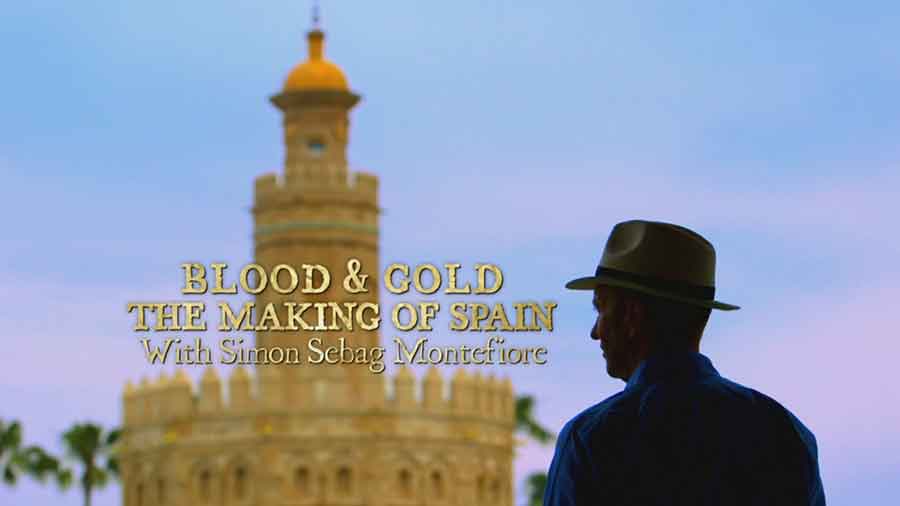Blood and Gold – The Making of Spain episode 2: Simon uncovers the truth about Spain’s hero El Cid. He also investigates the horror of the Spanish Inquisition and in the process discovers an unsettling story about one of his own ancestors.
Simon Sebag Montefiore embarks on a fascinating journey to unlock 2,000 years of Spain’s history.
Blood and Gold – The Making of Spain episode 2
Spain in the Middle Ages
In many ways, the history of Spain is marked by waves of conquerors who brought their distinct cultures to the peninsula. After the passage of the Vandals and Alans down the Mediterranean coast of Hispania from 408, the history of medieval Spain begins with the Iberian kingdom of the Arianist Visigoths (507–711), who were converted to Catholicism with their king Reccared in 587. Visigothic culture in Spain can be seen as a phenomenon of Late Antiquity as much as part of the Age of Migrations.
From Northern Africa in 711, the Muslim Umayyad Caliphate crossed into Spain, at the invitation of a Visigothic clan to assist it in rising against King Roderic. Over the period 711-788, the Umayyads conquered most of the lands of the Visigothic kingdom of Hispania and established the territory known as Al-Andalus. A revolt during the conquest established the Christian Kingdom of Asturias in the north of Spain.
Much of the period is marked by conflict between the Muslim and Christian states of Spain, referred to as the Reconquista, or the Reconquest (i.e., The Christians “reconquering” their lands as a religious crusade). The border between Muslim and Christian lands wavered southward through 700 years of war, which marked the peninsula as a militarily contested space. The medieval centuries also witnessed episodes of warfare between Spain’s Christian states. Wars between the Crown of Aragon and the Crown of Castile were sparked by dynastic rivalries or disagreements over tracts of land conquered or to be conquered from the Muslim south.
El Cid
Rodrigo Díaz de Vivar (c. 1043 – 10 July 1099) was a Castilian knight and warlord in medieval Spain. The Moors called him El Cid, which meant the Lord, and the Christians, El Campeador, which means “the Champion” in modern Spanish, but is idiomatically translated as “the Master of the Battlefield” in Old Spanish. He was born in Vivar del Cid, a village near the city of Burgos. Díaz de Vivar became well known for his service in the armies of both Christian and Muslim rulers, his exile, and his temporary conquest of Valencia, which became independent for a brief period in the Reconquista. After his death, El Cid became Spain’s celebrated national hero and the protagonist of the most significant medieval Spanish epic poem, El Cantar de Mio Cid.
Born a member of the minor nobility, El Cid was brought up at the court of Ferdinand the Great and served Ferdinand’s son, Sancho II of León and Castile. He rose to become the commander and royal standard-bearer (armiger regis) of Castile upon Sancho’s ascension in 1065. Rodrigo went on to lead the Castilian military campaigns against Sancho’s brothers, Alfonso VI of León and García II of Galicia, as well as in the Muslim kingdoms in al-Andalus.
He became renowned for his military prowess in these campaigns, which helped expand the territory of the Crown of Castile at the expense of the Muslims and Sancho’s brothers’ kingdoms. When conspirators murdered Sancho in 1072, Rodrigo found himself in a difficult situation. Since Sancho was childless, the throne passed to his brother Alfonso, whom El Cid had helped remove from power. Although Rodrigo continued to serve the sovereign, he lost his ranking in the new court, which treated him suspiciously and kept him at arm’s length. Finally, in 1081, he was exiled.
Spanish Inquisition – The Making of Spain episode 2
The Inquisition was a powerful office set up within the Catholic Church to root out and punish heresy throughout Europe and the Americas. Beginning in the 12th century and continuing for hundreds of years, the Inquisition is infamous for the severity of its tortures and its persecution of Jews and Muslims. Its worst manifestation was in Spain, where the Spanish Inquisition was a dominant force for more than 200 years, resulting in some 32,000 executions.
The Tribunal of the Holy Office of the Inquisition, commonly known as the Spanish Inquisition, was established in 1478 by Catholic Monarchs Ferdinand II of Aragon and Isabella I of Castile. It was intended to maintain Catholic orthodoxy in their kingdoms and to replace the Medieval Inquisition, which was under Papal control.
It became the most substantive of the three different manifestations of the wider Catholic Inquisition along with the Roman Inquisition and Portuguese Inquisition. The “Spanish Inquisition” may be defined broadly, operating in Spain and in all Spanish colonies and territories, which included the Canary Islands, the Kingdom of Naples,[citation needed] and all Spanish possessions in North, Central, and South America. According to modern estimates, around 150,000 were prosecuted for various offenses during the three-century duration of the Spanish Inquisition, out of which between 3,000 and 5,000 were executed (~2.7% of all cases).




